Photography & Ideology
VerifiedAdded on 2020/05/28
|10
|2598
|65
AI Summary
This assignment delves into the complex relationship between photography and ideology. It examines how photographers' intentions and underlying beliefs can influence the images they capture, ultimately shaping viewers' perceptions of social reality. Students are tasked with analyzing specific photographs, considering the photographer's perspective, photographic techniques used, and the potential for distortion in representing social conditions.
Contribute Materials
Your contribution can guide someone’s learning journey. Share your
documents today.

Running head: PHOTOGRAPH ANALYSIS
PHOTOGRAPH ANALYSIS
Name of the student
Name of the university
Author note
PHOTOGRAPH ANALYSIS
Name of the student
Name of the university
Author note
Secure Best Marks with AI Grader
Need help grading? Try our AI Grader for instant feedback on your assignments.
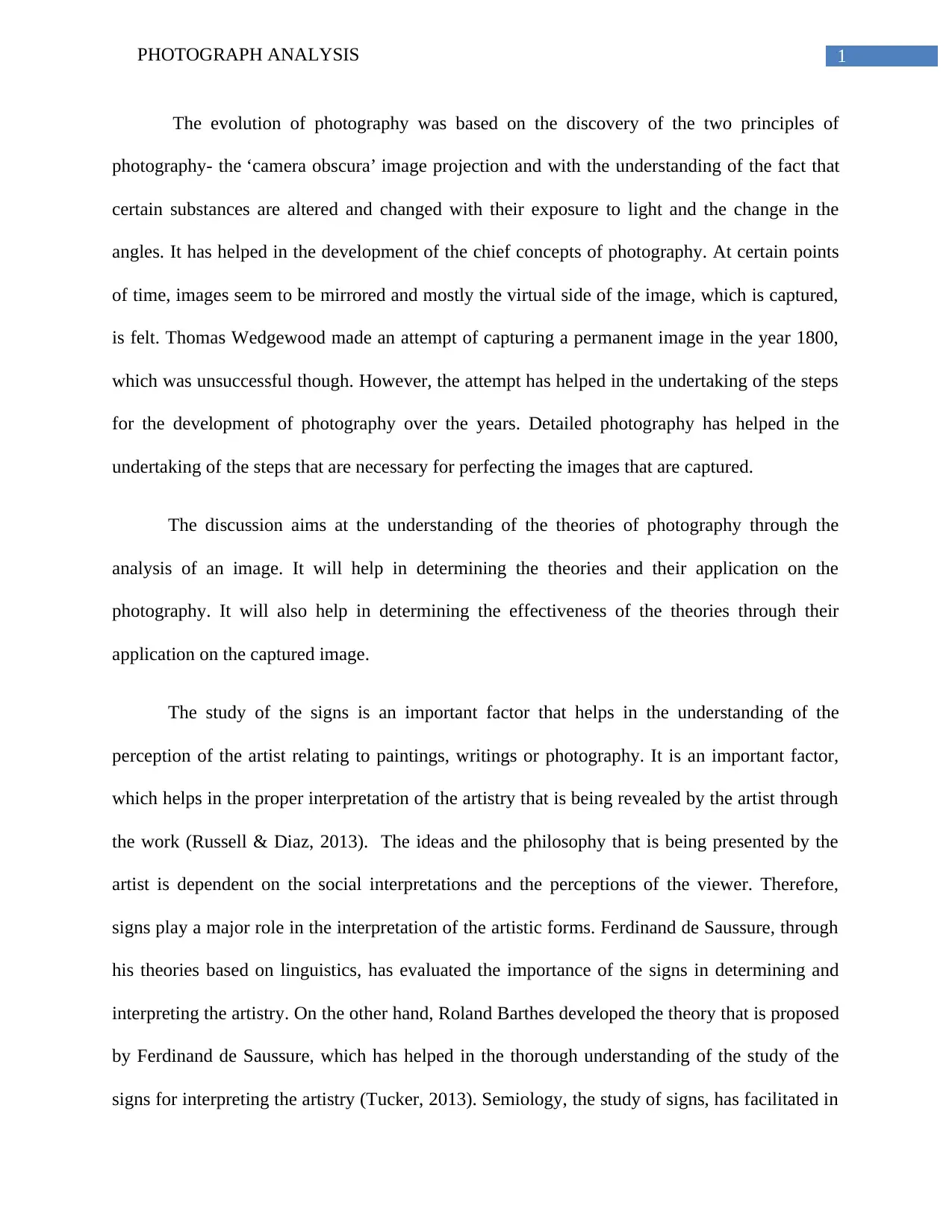
1PHOTOGRAPH ANALYSIS
The evolution of photography was based on the discovery of the two principles of
photography- the ‘camera obscura’ image projection and with the understanding of the fact that
certain substances are altered and changed with their exposure to light and the change in the
angles. It has helped in the development of the chief concepts of photography. At certain points
of time, images seem to be mirrored and mostly the virtual side of the image, which is captured,
is felt. Thomas Wedgewood made an attempt of capturing a permanent image in the year 1800,
which was unsuccessful though. However, the attempt has helped in the undertaking of the steps
for the development of photography over the years. Detailed photography has helped in the
undertaking of the steps that are necessary for perfecting the images that are captured.
The discussion aims at the understanding of the theories of photography through the
analysis of an image. It will help in determining the theories and their application on the
photography. It will also help in determining the effectiveness of the theories through their
application on the captured image.
The study of the signs is an important factor that helps in the understanding of the
perception of the artist relating to paintings, writings or photography. It is an important factor,
which helps in the proper interpretation of the artistry that is being revealed by the artist through
the work (Russell & Diaz, 2013). The ideas and the philosophy that is being presented by the
artist is dependent on the social interpretations and the perceptions of the viewer. Therefore,
signs play a major role in the interpretation of the artistic forms. Ferdinand de Saussure, through
his theories based on linguistics, has evaluated the importance of the signs in determining and
interpreting the artistry. On the other hand, Roland Barthes developed the theory that is proposed
by Ferdinand de Saussure, which has helped in the thorough understanding of the study of the
signs for interpreting the artistry (Tucker, 2013). Semiology, the study of signs, has facilitated in
The evolution of photography was based on the discovery of the two principles of
photography- the ‘camera obscura’ image projection and with the understanding of the fact that
certain substances are altered and changed with their exposure to light and the change in the
angles. It has helped in the development of the chief concepts of photography. At certain points
of time, images seem to be mirrored and mostly the virtual side of the image, which is captured,
is felt. Thomas Wedgewood made an attempt of capturing a permanent image in the year 1800,
which was unsuccessful though. However, the attempt has helped in the undertaking of the steps
for the development of photography over the years. Detailed photography has helped in the
undertaking of the steps that are necessary for perfecting the images that are captured.
The discussion aims at the understanding of the theories of photography through the
analysis of an image. It will help in determining the theories and their application on the
photography. It will also help in determining the effectiveness of the theories through their
application on the captured image.
The study of the signs is an important factor that helps in the understanding of the
perception of the artist relating to paintings, writings or photography. It is an important factor,
which helps in the proper interpretation of the artistry that is being revealed by the artist through
the work (Russell & Diaz, 2013). The ideas and the philosophy that is being presented by the
artist is dependent on the social interpretations and the perceptions of the viewer. Therefore,
signs play a major role in the interpretation of the artistic forms. Ferdinand de Saussure, through
his theories based on linguistics, has evaluated the importance of the signs in determining and
interpreting the artistry. On the other hand, Roland Barthes developed the theory that is proposed
by Ferdinand de Saussure, which has helped in the thorough understanding of the study of the
signs for interpreting the artistry (Tucker, 2013). Semiology, the study of signs, has facilitated in
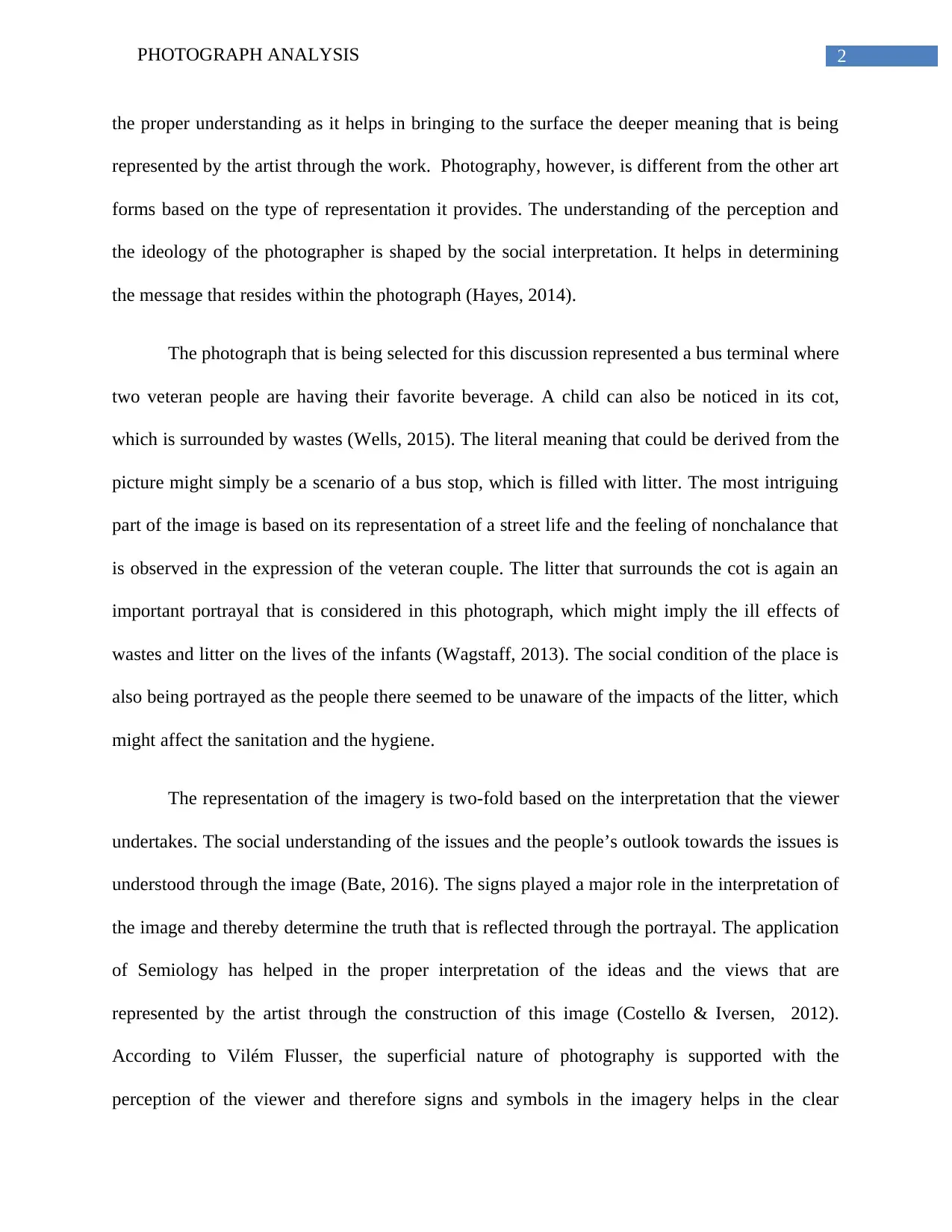
2PHOTOGRAPH ANALYSIS
the proper understanding as it helps in bringing to the surface the deeper meaning that is being
represented by the artist through the work. Photography, however, is different from the other art
forms based on the type of representation it provides. The understanding of the perception and
the ideology of the photographer is shaped by the social interpretation. It helps in determining
the message that resides within the photograph (Hayes, 2014).
The photograph that is being selected for this discussion represented a bus terminal where
two veteran people are having their favorite beverage. A child can also be noticed in its cot,
which is surrounded by wastes (Wells, 2015). The literal meaning that could be derived from the
picture might simply be a scenario of a bus stop, which is filled with litter. The most intriguing
part of the image is based on its representation of a street life and the feeling of nonchalance that
is observed in the expression of the veteran couple. The litter that surrounds the cot is again an
important portrayal that is considered in this photograph, which might imply the ill effects of
wastes and litter on the lives of the infants (Wagstaff, 2013). The social condition of the place is
also being portrayed as the people there seemed to be unaware of the impacts of the litter, which
might affect the sanitation and the hygiene.
The representation of the imagery is two-fold based on the interpretation that the viewer
undertakes. The social understanding of the issues and the people’s outlook towards the issues is
understood through the image (Bate, 2016). The signs played a major role in the interpretation of
the image and thereby determine the truth that is reflected through the portrayal. The application
of Semiology has helped in the proper interpretation of the ideas and the views that are
represented by the artist through the construction of this image (Costello & Iversen, 2012).
According to Vilém Flusser, the superficial nature of photography is supported with the
perception of the viewer and therefore signs and symbols in the imagery helps in the clear
the proper understanding as it helps in bringing to the surface the deeper meaning that is being
represented by the artist through the work. Photography, however, is different from the other art
forms based on the type of representation it provides. The understanding of the perception and
the ideology of the photographer is shaped by the social interpretation. It helps in determining
the message that resides within the photograph (Hayes, 2014).
The photograph that is being selected for this discussion represented a bus terminal where
two veteran people are having their favorite beverage. A child can also be noticed in its cot,
which is surrounded by wastes (Wells, 2015). The literal meaning that could be derived from the
picture might simply be a scenario of a bus stop, which is filled with litter. The most intriguing
part of the image is based on its representation of a street life and the feeling of nonchalance that
is observed in the expression of the veteran couple. The litter that surrounds the cot is again an
important portrayal that is considered in this photograph, which might imply the ill effects of
wastes and litter on the lives of the infants (Wagstaff, 2013). The social condition of the place is
also being portrayed as the people there seemed to be unaware of the impacts of the litter, which
might affect the sanitation and the hygiene.
The representation of the imagery is two-fold based on the interpretation that the viewer
undertakes. The social understanding of the issues and the people’s outlook towards the issues is
understood through the image (Bate, 2016). The signs played a major role in the interpretation of
the image and thereby determine the truth that is reflected through the portrayal. The application
of Semiology has helped in the proper interpretation of the ideas and the views that are
represented by the artist through the construction of this image (Costello & Iversen, 2012).
According to Vilém Flusser, the superficial nature of photography is supported with the
perception of the viewer and therefore signs and symbols in the imagery helps in the clear
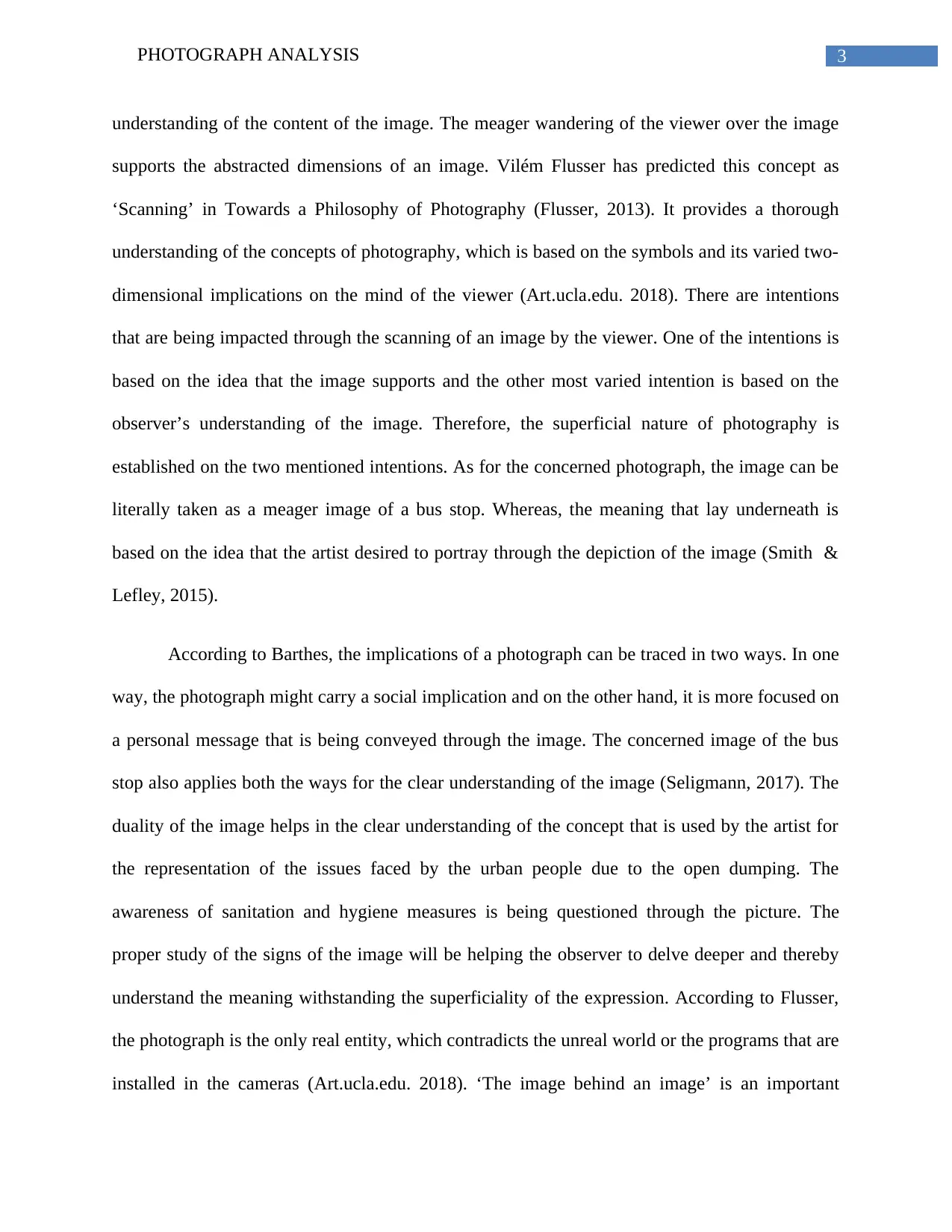
3PHOTOGRAPH ANALYSIS
understanding of the content of the image. The meager wandering of the viewer over the image
supports the abstracted dimensions of an image. Vilém Flusser has predicted this concept as
‘Scanning’ in Towards a Philosophy of Photography (Flusser, 2013). It provides a thorough
understanding of the concepts of photography, which is based on the symbols and its varied two-
dimensional implications on the mind of the viewer (Art.ucla.edu. 2018). There are intentions
that are being impacted through the scanning of an image by the viewer. One of the intentions is
based on the idea that the image supports and the other most varied intention is based on the
observer’s understanding of the image. Therefore, the superficial nature of photography is
established on the two mentioned intentions. As for the concerned photograph, the image can be
literally taken as a meager image of a bus stop. Whereas, the meaning that lay underneath is
based on the idea that the artist desired to portray through the depiction of the image (Smith &
Lefley, 2015).
According to Barthes, the implications of a photograph can be traced in two ways. In one
way, the photograph might carry a social implication and on the other hand, it is more focused on
a personal message that is being conveyed through the image. The concerned image of the bus
stop also applies both the ways for the clear understanding of the image (Seligmann, 2017). The
duality of the image helps in the clear understanding of the concept that is used by the artist for
the representation of the issues faced by the urban people due to the open dumping. The
awareness of sanitation and hygiene measures is being questioned through the picture. The
proper study of the signs of the image will be helping the observer to delve deeper and thereby
understand the meaning withstanding the superficiality of the expression. According to Flusser,
the photograph is the only real entity, which contradicts the unreal world or the programs that are
installed in the cameras (Art.ucla.edu. 2018). ‘The image behind an image’ is an important
understanding of the content of the image. The meager wandering of the viewer over the image
supports the abstracted dimensions of an image. Vilém Flusser has predicted this concept as
‘Scanning’ in Towards a Philosophy of Photography (Flusser, 2013). It provides a thorough
understanding of the concepts of photography, which is based on the symbols and its varied two-
dimensional implications on the mind of the viewer (Art.ucla.edu. 2018). There are intentions
that are being impacted through the scanning of an image by the viewer. One of the intentions is
based on the idea that the image supports and the other most varied intention is based on the
observer’s understanding of the image. Therefore, the superficial nature of photography is
established on the two mentioned intentions. As for the concerned photograph, the image can be
literally taken as a meager image of a bus stop. Whereas, the meaning that lay underneath is
based on the idea that the artist desired to portray through the depiction of the image (Smith &
Lefley, 2015).
According to Barthes, the implications of a photograph can be traced in two ways. In one
way, the photograph might carry a social implication and on the other hand, it is more focused on
a personal message that is being conveyed through the image. The concerned image of the bus
stop also applies both the ways for the clear understanding of the image (Seligmann, 2017). The
duality of the image helps in the clear understanding of the concept that is used by the artist for
the representation of the issues faced by the urban people due to the open dumping. The
awareness of sanitation and hygiene measures is being questioned through the picture. The
proper study of the signs of the image will be helping the observer to delve deeper and thereby
understand the meaning withstanding the superficiality of the expression. According to Flusser,
the photograph is the only real entity, which contradicts the unreal world or the programs that are
installed in the cameras (Art.ucla.edu. 2018). ‘The image behind an image’ is an important
Secure Best Marks with AI Grader
Need help grading? Try our AI Grader for instant feedback on your assignments.
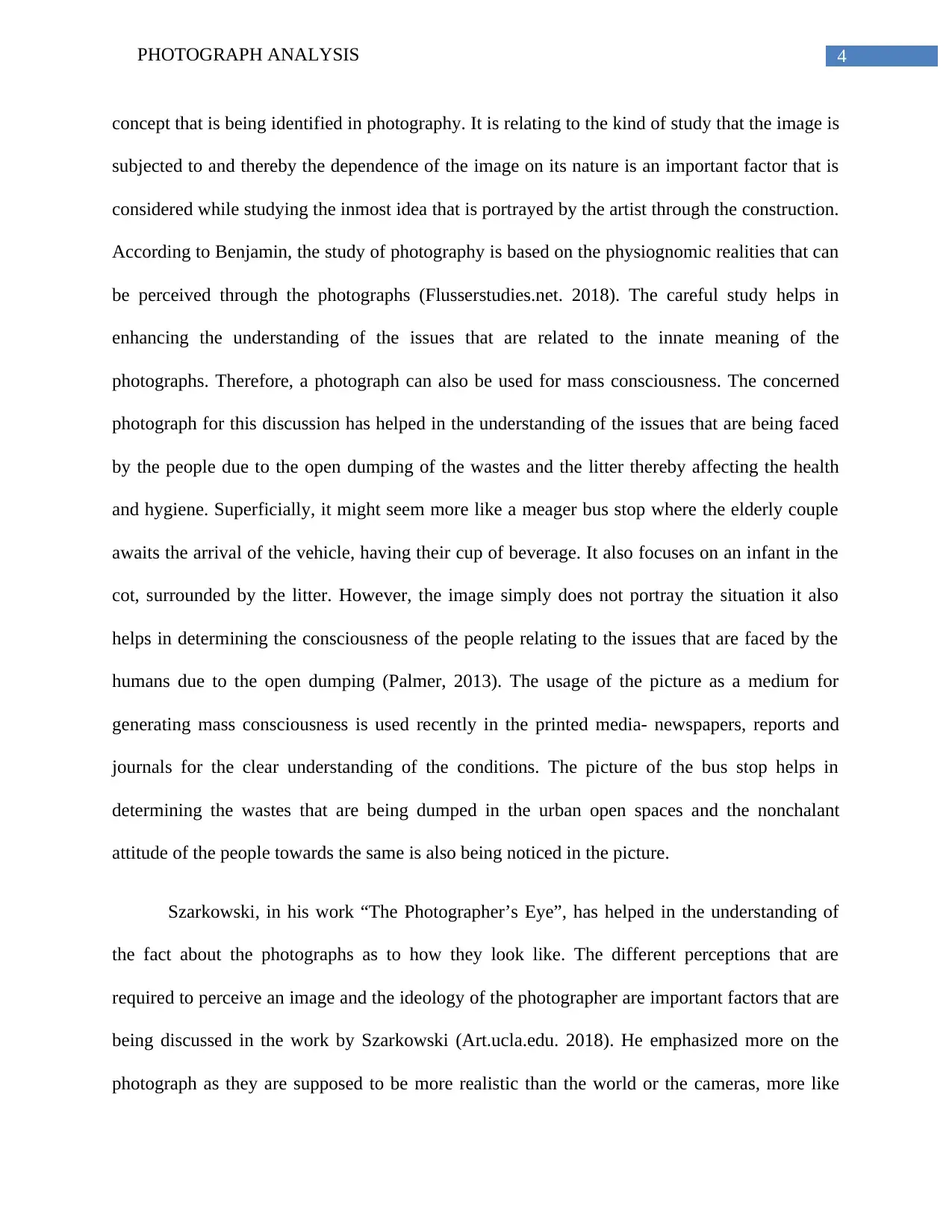
4PHOTOGRAPH ANALYSIS
concept that is being identified in photography. It is relating to the kind of study that the image is
subjected to and thereby the dependence of the image on its nature is an important factor that is
considered while studying the inmost idea that is portrayed by the artist through the construction.
According to Benjamin, the study of photography is based on the physiognomic realities that can
be perceived through the photographs (Flusserstudies.net. 2018). The careful study helps in
enhancing the understanding of the issues that are related to the innate meaning of the
photographs. Therefore, a photograph can also be used for mass consciousness. The concerned
photograph for this discussion has helped in the understanding of the issues that are being faced
by the people due to the open dumping of the wastes and the litter thereby affecting the health
and hygiene. Superficially, it might seem more like a meager bus stop where the elderly couple
awaits the arrival of the vehicle, having their cup of beverage. It also focuses on an infant in the
cot, surrounded by the litter. However, the image simply does not portray the situation it also
helps in determining the consciousness of the people relating to the issues that are faced by the
humans due to the open dumping (Palmer, 2013). The usage of the picture as a medium for
generating mass consciousness is used recently in the printed media- newspapers, reports and
journals for the clear understanding of the conditions. The picture of the bus stop helps in
determining the wastes that are being dumped in the urban open spaces and the nonchalant
attitude of the people towards the same is also being noticed in the picture.
Szarkowski, in his work “The Photographer’s Eye”, has helped in the understanding of
the fact about the photographs as to how they look like. The different perceptions that are
required to perceive an image and the ideology of the photographer are important factors that are
being discussed in the work by Szarkowski (Art.ucla.edu. 2018). He emphasized more on the
photograph as they are supposed to be more realistic than the world or the cameras, more like
concept that is being identified in photography. It is relating to the kind of study that the image is
subjected to and thereby the dependence of the image on its nature is an important factor that is
considered while studying the inmost idea that is portrayed by the artist through the construction.
According to Benjamin, the study of photography is based on the physiognomic realities that can
be perceived through the photographs (Flusserstudies.net. 2018). The careful study helps in
enhancing the understanding of the issues that are related to the innate meaning of the
photographs. Therefore, a photograph can also be used for mass consciousness. The concerned
photograph for this discussion has helped in the understanding of the issues that are being faced
by the people due to the open dumping of the wastes and the litter thereby affecting the health
and hygiene. Superficially, it might seem more like a meager bus stop where the elderly couple
awaits the arrival of the vehicle, having their cup of beverage. It also focuses on an infant in the
cot, surrounded by the litter. However, the image simply does not portray the situation it also
helps in determining the consciousness of the people relating to the issues that are faced by the
humans due to the open dumping (Palmer, 2013). The usage of the picture as a medium for
generating mass consciousness is used recently in the printed media- newspapers, reports and
journals for the clear understanding of the conditions. The picture of the bus stop helps in
determining the wastes that are being dumped in the urban open spaces and the nonchalant
attitude of the people towards the same is also being noticed in the picture.
Szarkowski, in his work “The Photographer’s Eye”, has helped in the understanding of
the fact about the photographs as to how they look like. The different perceptions that are
required to perceive an image and the ideology of the photographer are important factors that are
being discussed in the work by Szarkowski (Art.ucla.edu. 2018). He emphasized more on the
photograph as they are supposed to be more realistic than the world or the cameras, more like
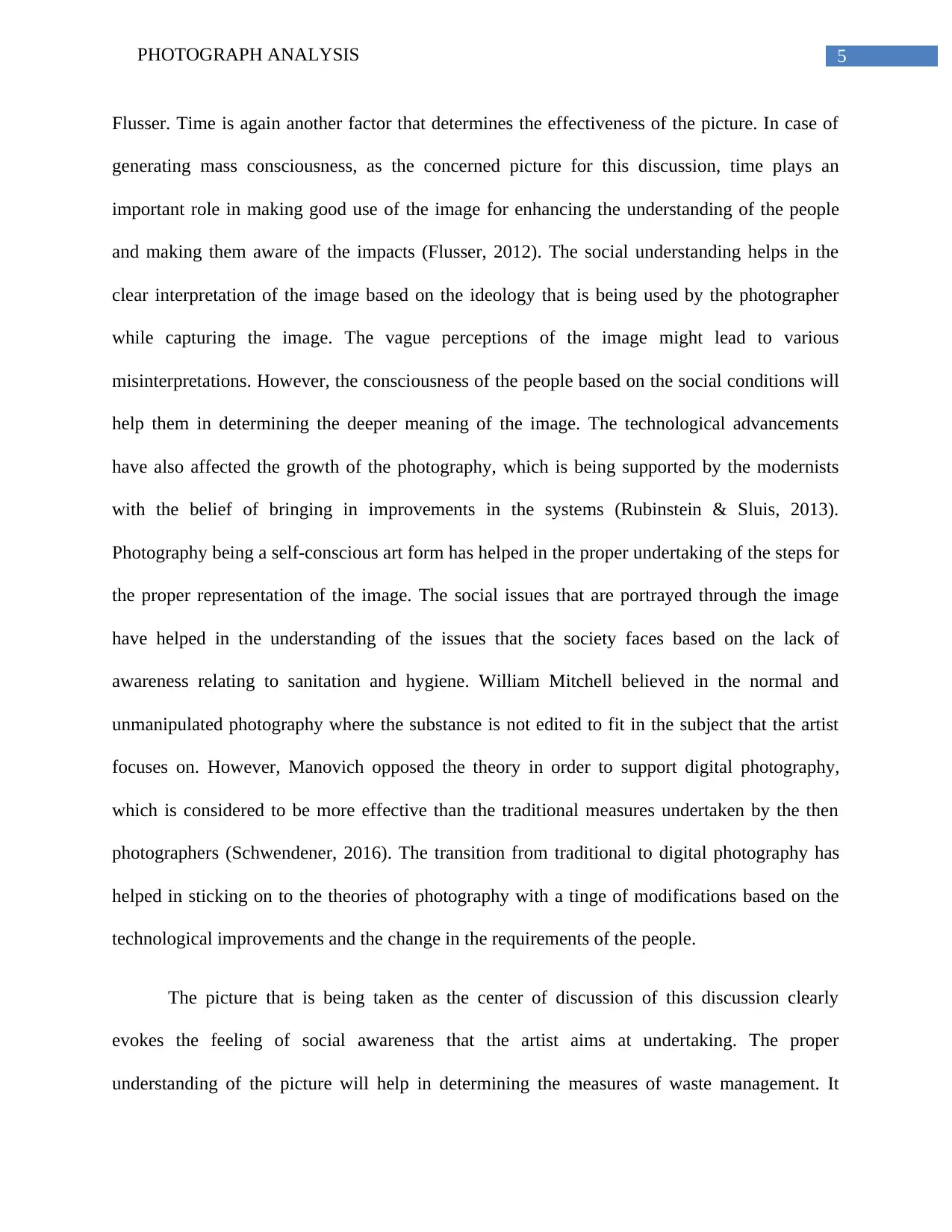
5PHOTOGRAPH ANALYSIS
Flusser. Time is again another factor that determines the effectiveness of the picture. In case of
generating mass consciousness, as the concerned picture for this discussion, time plays an
important role in making good use of the image for enhancing the understanding of the people
and making them aware of the impacts (Flusser, 2012). The social understanding helps in the
clear interpretation of the image based on the ideology that is being used by the photographer
while capturing the image. The vague perceptions of the image might lead to various
misinterpretations. However, the consciousness of the people based on the social conditions will
help them in determining the deeper meaning of the image. The technological advancements
have also affected the growth of the photography, which is being supported by the modernists
with the belief of bringing in improvements in the systems (Rubinstein & Sluis, 2013).
Photography being a self-conscious art form has helped in the proper undertaking of the steps for
the proper representation of the image. The social issues that are portrayed through the image
have helped in the understanding of the issues that the society faces based on the lack of
awareness relating to sanitation and hygiene. William Mitchell believed in the normal and
unmanipulated photography where the substance is not edited to fit in the subject that the artist
focuses on. However, Manovich opposed the theory in order to support digital photography,
which is considered to be more effective than the traditional measures undertaken by the then
photographers (Schwendener, 2016). The transition from traditional to digital photography has
helped in sticking on to the theories of photography with a tinge of modifications based on the
technological improvements and the change in the requirements of the people.
The picture that is being taken as the center of discussion of this discussion clearly
evokes the feeling of social awareness that the artist aims at undertaking. The proper
understanding of the picture will help in determining the measures of waste management. It
Flusser. Time is again another factor that determines the effectiveness of the picture. In case of
generating mass consciousness, as the concerned picture for this discussion, time plays an
important role in making good use of the image for enhancing the understanding of the people
and making them aware of the impacts (Flusser, 2012). The social understanding helps in the
clear interpretation of the image based on the ideology that is being used by the photographer
while capturing the image. The vague perceptions of the image might lead to various
misinterpretations. However, the consciousness of the people based on the social conditions will
help them in determining the deeper meaning of the image. The technological advancements
have also affected the growth of the photography, which is being supported by the modernists
with the belief of bringing in improvements in the systems (Rubinstein & Sluis, 2013).
Photography being a self-conscious art form has helped in the proper undertaking of the steps for
the proper representation of the image. The social issues that are portrayed through the image
have helped in the understanding of the issues that the society faces based on the lack of
awareness relating to sanitation and hygiene. William Mitchell believed in the normal and
unmanipulated photography where the substance is not edited to fit in the subject that the artist
focuses on. However, Manovich opposed the theory in order to support digital photography,
which is considered to be more effective than the traditional measures undertaken by the then
photographers (Schwendener, 2016). The transition from traditional to digital photography has
helped in sticking on to the theories of photography with a tinge of modifications based on the
technological improvements and the change in the requirements of the people.
The picture that is being taken as the center of discussion of this discussion clearly
evokes the feeling of social awareness that the artist aims at undertaking. The proper
understanding of the picture will help in determining the measures of waste management. It
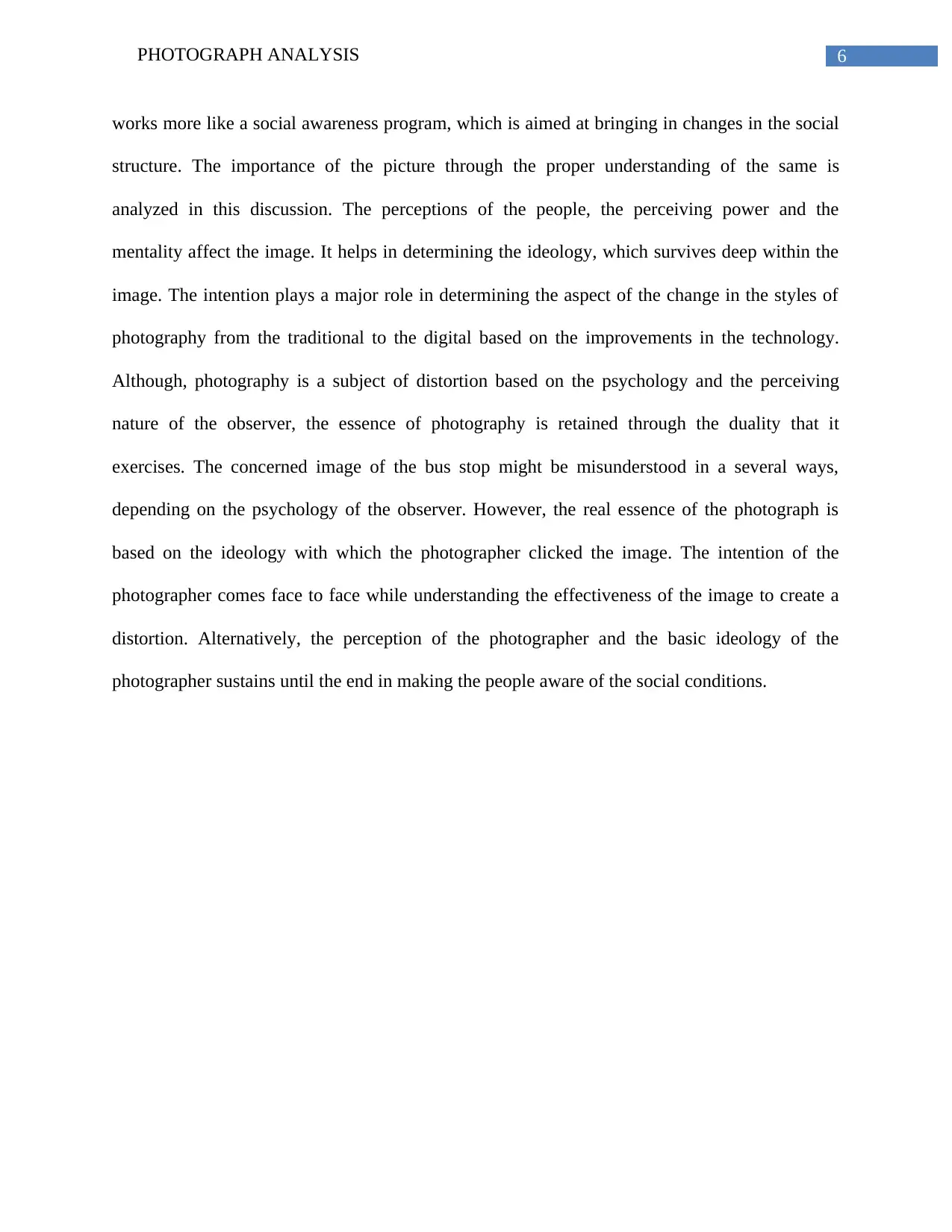
6PHOTOGRAPH ANALYSIS
works more like a social awareness program, which is aimed at bringing in changes in the social
structure. The importance of the picture through the proper understanding of the same is
analyzed in this discussion. The perceptions of the people, the perceiving power and the
mentality affect the image. It helps in determining the ideology, which survives deep within the
image. The intention plays a major role in determining the aspect of the change in the styles of
photography from the traditional to the digital based on the improvements in the technology.
Although, photography is a subject of distortion based on the psychology and the perceiving
nature of the observer, the essence of photography is retained through the duality that it
exercises. The concerned image of the bus stop might be misunderstood in a several ways,
depending on the psychology of the observer. However, the real essence of the photograph is
based on the ideology with which the photographer clicked the image. The intention of the
photographer comes face to face while understanding the effectiveness of the image to create a
distortion. Alternatively, the perception of the photographer and the basic ideology of the
photographer sustains until the end in making the people aware of the social conditions.
works more like a social awareness program, which is aimed at bringing in changes in the social
structure. The importance of the picture through the proper understanding of the same is
analyzed in this discussion. The perceptions of the people, the perceiving power and the
mentality affect the image. It helps in determining the ideology, which survives deep within the
image. The intention plays a major role in determining the aspect of the change in the styles of
photography from the traditional to the digital based on the improvements in the technology.
Although, photography is a subject of distortion based on the psychology and the perceiving
nature of the observer, the essence of photography is retained through the duality that it
exercises. The concerned image of the bus stop might be misunderstood in a several ways,
depending on the psychology of the observer. However, the real essence of the photograph is
based on the ideology with which the photographer clicked the image. The intention of the
photographer comes face to face while understanding the effectiveness of the image to create a
distortion. Alternatively, the perception of the photographer and the basic ideology of the
photographer sustains until the end in making the people aware of the social conditions.
Paraphrase This Document
Need a fresh take? Get an instant paraphrase of this document with our AI Paraphraser
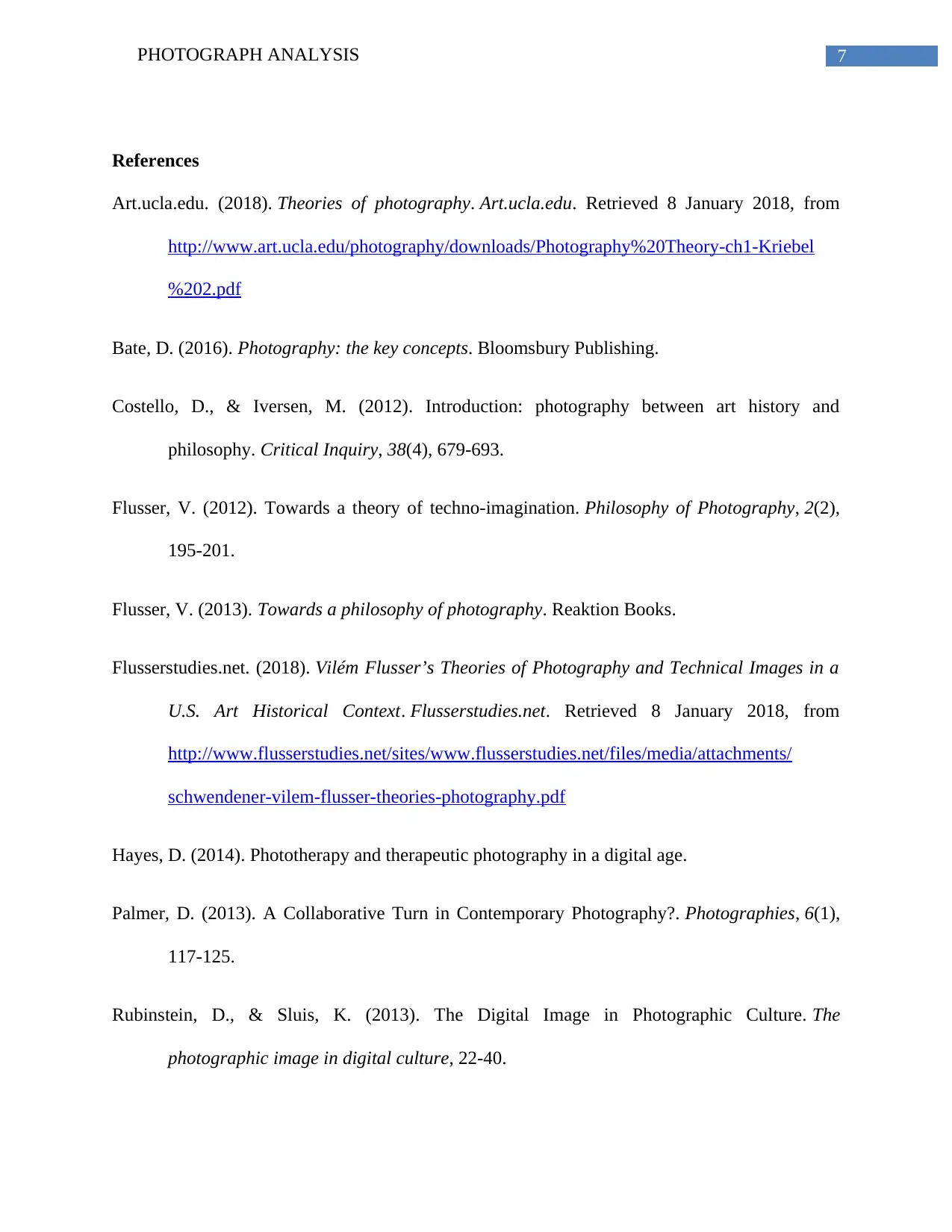
7PHOTOGRAPH ANALYSIS
References
Art.ucla.edu. (2018). Theories of photography. Art.ucla.edu. Retrieved 8 January 2018, from
http://www.art.ucla.edu/photography/downloads/Photography%20Theory-ch1-Kriebel
%202.pdf
Bate, D. (2016). Photography: the key concepts. Bloomsbury Publishing.
Costello, D., & Iversen, M. (2012). Introduction: photography between art history and
philosophy. Critical Inquiry, 38(4), 679-693.
Flusser, V. (2012). Towards a theory of techno-imagination. Philosophy of Photography, 2(2),
195-201.
Flusser, V. (2013). Towards a philosophy of photography. Reaktion Books.
Flusserstudies.net. (2018). Vilém Flusser’s Theories of Photography and Technical Images in a
U.S. Art Historical Context. Flusserstudies.net. Retrieved 8 January 2018, from
http://www.flusserstudies.net/sites/www.flusserstudies.net/files/media/attachments/
schwendener-vilem-flusser-theories-photography.pdf
Hayes, D. (2014). Phototherapy and therapeutic photography in a digital age.
Palmer, D. (2013). A Collaborative Turn in Contemporary Photography?. Photographies, 6(1),
117-125.
Rubinstein, D., & Sluis, K. (2013). The Digital Image in Photographic Culture. The
photographic image in digital culture, 22-40.
References
Art.ucla.edu. (2018). Theories of photography. Art.ucla.edu. Retrieved 8 January 2018, from
http://www.art.ucla.edu/photography/downloads/Photography%20Theory-ch1-Kriebel
%202.pdf
Bate, D. (2016). Photography: the key concepts. Bloomsbury Publishing.
Costello, D., & Iversen, M. (2012). Introduction: photography between art history and
philosophy. Critical Inquiry, 38(4), 679-693.
Flusser, V. (2012). Towards a theory of techno-imagination. Philosophy of Photography, 2(2),
195-201.
Flusser, V. (2013). Towards a philosophy of photography. Reaktion Books.
Flusserstudies.net. (2018). Vilém Flusser’s Theories of Photography and Technical Images in a
U.S. Art Historical Context. Flusserstudies.net. Retrieved 8 January 2018, from
http://www.flusserstudies.net/sites/www.flusserstudies.net/files/media/attachments/
schwendener-vilem-flusser-theories-photography.pdf
Hayes, D. (2014). Phototherapy and therapeutic photography in a digital age.
Palmer, D. (2013). A Collaborative Turn in Contemporary Photography?. Photographies, 6(1),
117-125.
Rubinstein, D., & Sluis, K. (2013). The Digital Image in Photographic Culture. The
photographic image in digital culture, 22-40.
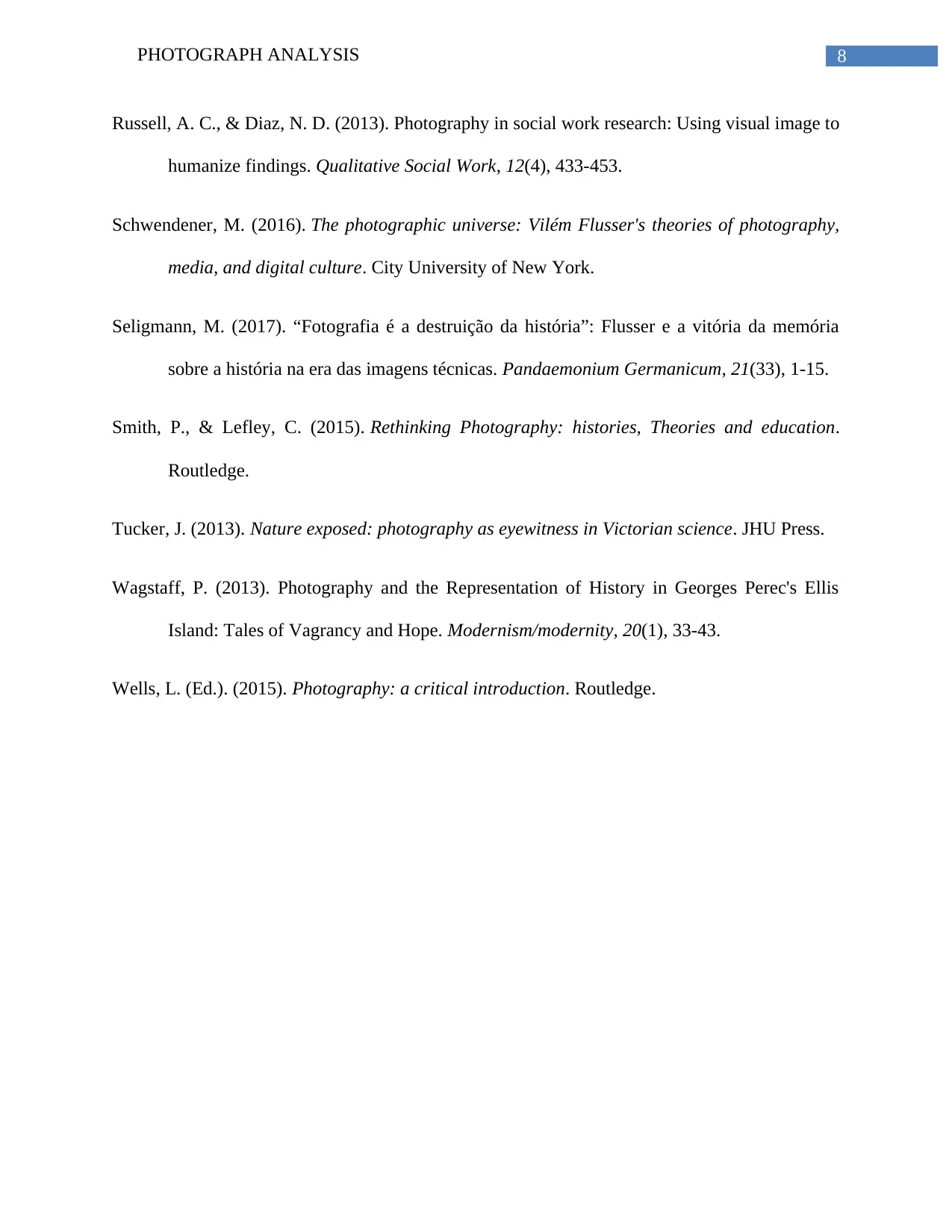
8PHOTOGRAPH ANALYSIS
Russell, A. C., & Diaz, N. D. (2013). Photography in social work research: Using visual image to
humanize findings. Qualitative Social Work, 12(4), 433-453.
Schwendener, M. (2016). The photographic universe: Vilém Flusser's theories of photography,
media, and digital culture. City University of New York.
Seligmann, M. (2017). “Fotografia é a destruição da história”: Flusser e a vitória da memória
sobre a história na era das imagens técnicas. Pandaemonium Germanicum, 21(33), 1-15.
Smith, P., & Lefley, C. (2015). Rethinking Photography: histories, Theories and education.
Routledge.
Tucker, J. (2013). Nature exposed: photography as eyewitness in Victorian science. JHU Press.
Wagstaff, P. (2013). Photography and the Representation of History in Georges Perec's Ellis
Island: Tales of Vagrancy and Hope. Modernism/modernity, 20(1), 33-43.
Wells, L. (Ed.). (2015). Photography: a critical introduction. Routledge.
Russell, A. C., & Diaz, N. D. (2013). Photography in social work research: Using visual image to
humanize findings. Qualitative Social Work, 12(4), 433-453.
Schwendener, M. (2016). The photographic universe: Vilém Flusser's theories of photography,
media, and digital culture. City University of New York.
Seligmann, M. (2017). “Fotografia é a destruição da história”: Flusser e a vitória da memória
sobre a história na era das imagens técnicas. Pandaemonium Germanicum, 21(33), 1-15.
Smith, P., & Lefley, C. (2015). Rethinking Photography: histories, Theories and education.
Routledge.
Tucker, J. (2013). Nature exposed: photography as eyewitness in Victorian science. JHU Press.
Wagstaff, P. (2013). Photography and the Representation of History in Georges Perec's Ellis
Island: Tales of Vagrancy and Hope. Modernism/modernity, 20(1), 33-43.
Wells, L. (Ed.). (2015). Photography: a critical introduction. Routledge.
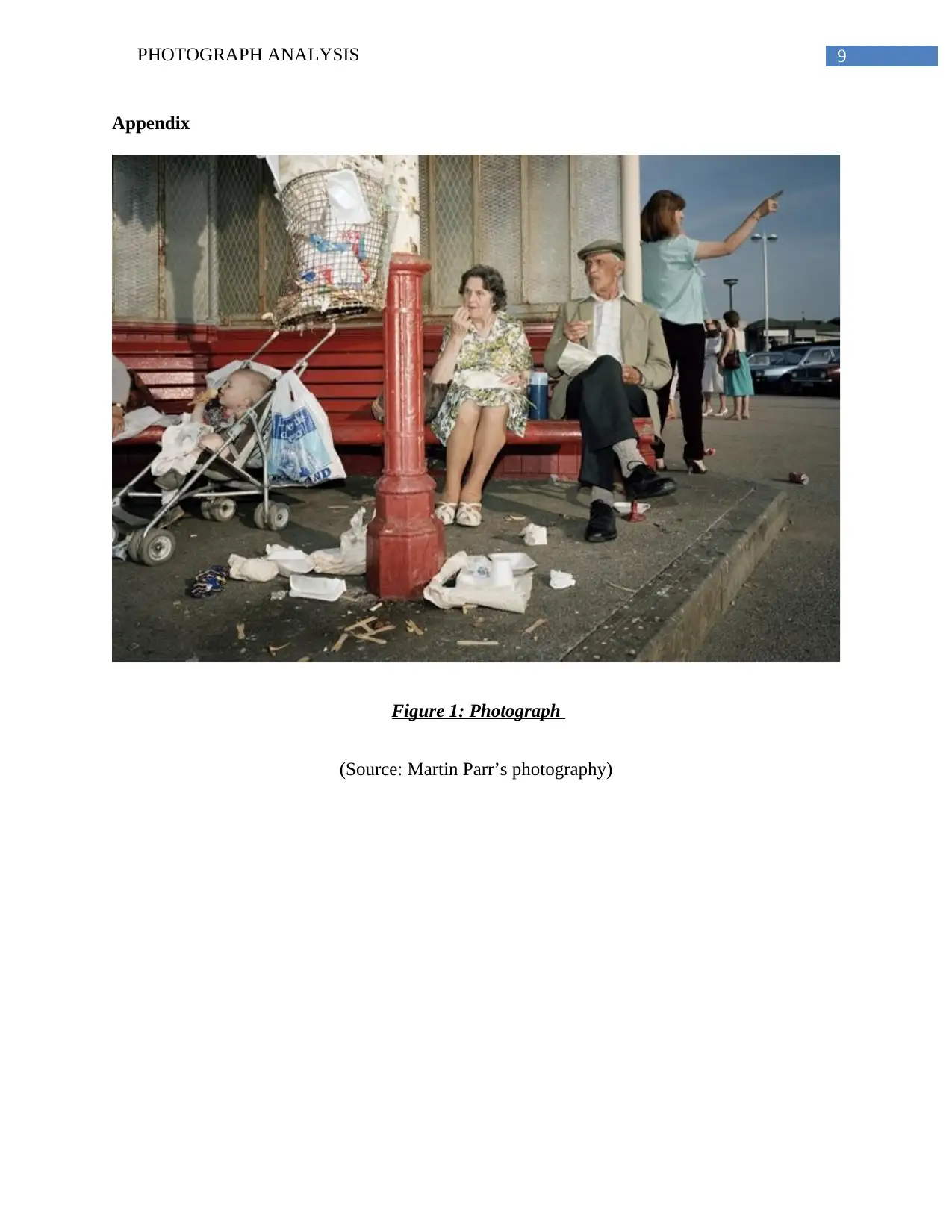
9PHOTOGRAPH ANALYSIS
Appendix
Figure 1: Photograph
(Source: Martin Parr’s photography)
Appendix
Figure 1: Photograph
(Source: Martin Parr’s photography)
1 out of 10
Related Documents
Your All-in-One AI-Powered Toolkit for Academic Success.
+13062052269
info@desklib.com
Available 24*7 on WhatsApp / Email
![[object Object]](/_next/static/media/star-bottom.7253800d.svg)
Unlock your academic potential
© 2024 | Zucol Services PVT LTD | All rights reserved.





